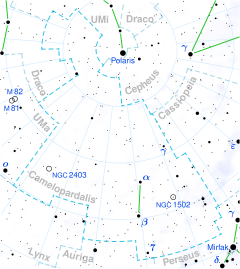8 카멜로파르다리스
8 Camelopardalis| 관찰 데이터 에폭J2000.0에쿼녹스J2000.0 | |
|---|---|
| 콘스텔레이션 | 카멜로파르다리스 |
| 적경 | 04h 59m 46.32836s[1] |
| 적위 | +53° 09° 19.6253°[1] |
| 겉보기 등급(V) | 6.09[2] |
| 특성. | |
| 진화 단계 | 거인[3] |
| 스펙트럼형 | K4 III[4] |
| B-V 색지수 | 1.462±0.009[2] |
| 아스트로메트리 | |
| 반지름 속도(Rv) | - 0.01±0[1].13km/s |
| 고유운동(μ) | RA: - 13.532[1] mas/년 Dec.: - 10.700[1] mas/년 |
| 시차()) | 4.1409 ± 0.0613[1] mas |
| 거리 | 750 ± 10 리 (229 ± 3 pc) |
| 절대 등급(MV) | - 0.11[2] |
| 세부 사항 | |
| 덩어리 | 1.13[5] M☉ |
| 반지름 | 30.19±3.31[3] R☉ |
| 광도 | 341±6[1] L☉ |
| 표면 중력(log g) | 2.8kg[3] |
| 온도 | 4,257 + 978 - 420[1] K |
| 금속성 [Fe/H] | +0[3].06덱스 |
| 회전 속도(v sin i) | 1.6[6] km/s |
| 기타 명칭 | |
| 데이터베이스 참조 | |
| 심바디 | 데이터. |
8 카멜라파다리스는 [7]북쪽 극주변 카멜라파다리스자리에 있는 별입니다.겉보기 등급 6.09의 [2]어두운 오렌지빛 별처럼 보이는 것은 육안으로 보기 어려운 일이다.시차를 기준으로 볼 때,[1] 태양으로부터 약 750광년 떨어져 있습니다.그 거리에서는 성간 [8]먼지로 인해 시야가 0.58만큼 감소합니다.
이 별은 K4 III [4]등급의 K형 거성으로 중심핵의 수소를 소진하고 주계열에서 멀어져 진화했음을 나타냅니다.이 별은 태양 반지름의 30배까지[3] 팽창했으며 4,257 [1]K의 유효 온도에서 확대된 광구에서 태양의 341배의[1] 광도를 방출하고 있습니다.
레퍼런스
- ^ a b c d e f g h i j k VizieR에서 이 소스에 Brown, A. G. A.; et al. (Gaia collaboration) (August 2018). "Gaia Data Release 2: Summary of the contents and survey properties". Astronomy & Astrophysics. 616. A1. arXiv:1804.09365. Bibcode:2018A&A...616A...1G. doi:10.1051/0004-6361/201833051.대한 Gaia DR2 레코드.
- ^ a b c d Anderson, E.; Francis, Ch. (2012), "XHIP: An extended hipparcos compilation", Astronomy Letters, 38 (5): 331, arXiv:1108.4971, Bibcode:2012AstL...38..331A, doi:10.1134/S1063773712050015, S2CID 119257644.
- ^ a b c d e Baines, Ellyn K.; et al. (September 2016), "Spectroscopic and Interferometric Measurements of Nine K Giant Stars", The Astronomical Journal, 152 (3): 8, arXiv:1609.02379, Bibcode:2016AJ....152...66B, doi:10.3847/0004-6256/152/3/66, S2CID 52904703, 66.
- ^ a b Appenzeller, Immo (April 1967), "MK Spectral Types for 185 Bright Stars", Publications of the Astronomical Society of the Pacific, 79 (467): 102, Bibcode:1967PASP...79..102A, doi:10.1086/128449.
- ^ Anders, F.; Khalatyan, A.; Chiappini, C.; Queiroz, A. B.; Santiago, B. X.; Jordi, C.; Girardi, L.; Brown, A. G. A.; Matijevič, G.; Monari, G.; Cantat-Gaudin, T.; Weiler, M.; Khan, S.; Miglio, A.; Carrillo, I.; Romero-Gómez, M.; Minchev, I.; De Jong, R. S.; Antoja, T.; Ramos, P.; Steinmetz, M.; Enke, H. (2019), "Photo-astrometric distances, extinctions, and astrophysical parameters for Gaia DR2 stars brighter than G = 18", Astronomy and Astrophysics, 628: A94, arXiv:1904.11302, Bibcode:2019A&A...628A..94A, doi:10.1051/0004-6361/201935765, S2CID 131780028.
- ^ De Medeiros, J. R.; et al. (November 2000), "Rotation and lithium in single giant stars", Astronomy and Astrophysics, 363: 239–243, arXiv:astro-ph/0010273, Bibcode:2000A&A...363..239D.
- ^ a b "8 Cam". SIMBAD. Centre de données astronomiques de Strasbourg. Retrieved 2019-04-15.
- ^ Famaey, B.; et al. (January 2005), "Local kinematics of K and M giants from CORAVEL/Hipparcos/Tycho-2 data. Revisiting the concept of superclusters", Astronomy and Astrophysics, 430 (1): 165–186, arXiv:astro-ph/0409579, Bibcode:2005A&A...430..165F, doi:10.1051/0004-6361:20041272, S2CID 17804304.



